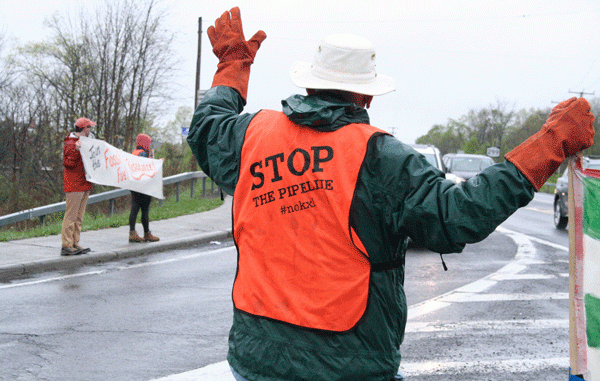
Waves and honks of encouragement kept the morale of 50 New Paltz Pilgrim Pipeline protestors high and bright on a rainy cold day at the New York Authority Thruway, New Paltz Exit 18.
On May 1, activists from the New Paltz Climate Coalition (NPCC) and the Coalition Against the Pilgrim Pipelines held their “Mayday! Mayday!” protests at three different locations in New York including New Paltz, Catskill and Saugerties to demonstrate against the proposed twin crude oil and petroleum pipeline. The pipeline has yet to be approved.
The pipeline would run 178-miles underground from Albany to various points of distributions before turning east at I-287 to reach refineries at Petroleum Administration for Defense Districts (East Coast region PADD 1), according to Pilgrim Pipeline Holdings, LLC.
Protesters held their demonstrations at the Thruway Authority Exits at their individual towns to symbolize that the pipelines will be running beneath major roads and cities.
On Jan. 20, 2016 the New Paltz Town Board unanimously passed a resolution publicly opposing the Pilgrim Pipeline. The resolution warns of possible negative outcomes the pipeline implementation may cause, including the jeopardization of the groundwater which the New Paltz community relies on.
All protesters at the demonstration expressed gratitude to the board for their leadership against the pipeline.
The resolution urges the New York State Thruway Authority to “reject use of its right-of-way for the purpose of transporting oil or gasoline by pipeline.”
According to NPCC protestors, the pipeline raises concern over the maintainence of drinking water quality, overall safety, threats to climate and regional economic well-being and public health.
Barbara Kidney of Shawangunk participated in the protest and expressed her disgust toward Gov. Andrew Cuomo, saying that he is a political animal adhering to billionaires in the fossil fuel business who would profit off of such a project.
“A pipe burst would cause complete contamination to the underground municipal water these towns rely on,” said Jurgen Wekerle of the Sierra Club, a grassroots environmental organization. “Such a spill could cause water depletion, toxic air emissions and methane release.”
Protester Ed Haffmanas explained his ideology that there should not even be a reinvestment in fossil fuels at this point. Many public subways and buses are run successful on electricity, according to Haffmanas.
“It moves us toward a more sustainable future,” Haffmanas said. “It is bound to happen eventually.”
Haffmanas himself drives an old mercedes that runs on vegetable oil. Cars like these are considered “grease cars” and are becoming popular with those who know how to change their engine to take grease as fuel.
NPCC member Dan Guenther said the protest had very little interaction with state troopers concerning their presence on the thruway. Guenther said the New York Department of Transportation (DOT) helped them get permission to use the sidewalk and that the coalitions’ good relationship with the police also aided in the ease of the protest.
“We let the police know whenever we would be having a demonstration,” Guenther said.
Guenther said that as a longtime protester, going through the process of speaking with officials and representatives of organizations to get a point across doesn’t always work out, which is why protesters take to the streets. In past protests, Guenther said this has been a successful method that receives a lot of attention and can really make a difference when done right.
First-year political science major Isabelle Hayes described her experience at this protest as encouraging due to the amount of honks and “thumbs up” they received by passerbys. Hayes said that even if just a few of passerbyers decided to go home and research the issue, the protest is warranted successful.
“We are spreading awareness,” Hayes said. “This is my first protest and I am absolutely loving it.”
